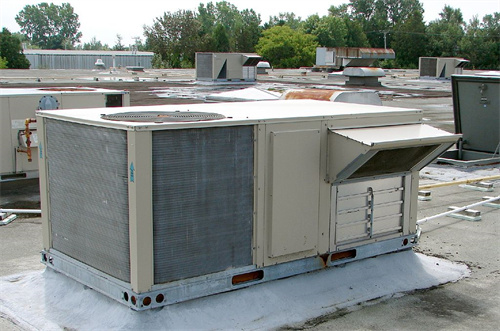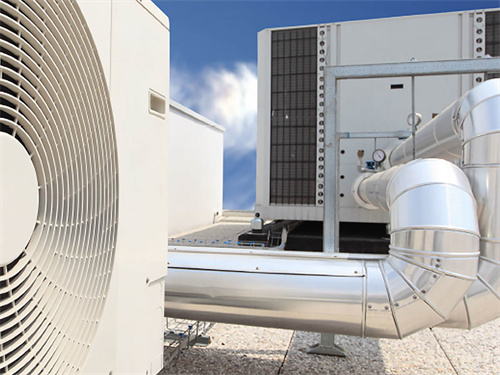The subsystems of the HVAC system mainly include: heating system, ventilation system and air conditioning system.
The heating system mainly includes hot water heating and steam heating. Hot water heating is more popular in buildings. Hot water heating uses hot water to circulate heat with secondary heat exchangers to maintain indoor temperature. The basic components of the system include: boiler, circulating pump, secondary heat exchanger, piping system and indoor terminal. And Kingflex rubber foam insulation products plays an important role in anti-condensation of pipeline system.
Ventilation refers to the process of sending fresh air and removing waste air in indoor spaces. The main purpose of ventilation is to ensure indoor air quality, and proper ventilation can also reduce the temperature of indoor spaces. Ventilation includes both natural ventilation and mechanical (forced) ventilation.
An air conditioning system is a combination of equipment composed of various components that regulate the air inside a building under human control to achieve the required conditions. Its basic function is to treat the air sent into the building to a certain state to eliminate the residual heat and residual humidity in the room, so that the temperature and humidity are kept within the acceptable range for the human body.
A complete and independent air conditioning system can be basically divided into three parts, namely: cold and heat sources and air handling equipment, air and cold and hot water distribution systems, and indoor terminal devices.
Kingflex rubber foam insulation tube is the best choice for air condition systems
Classification and basic principles of HVAC systems
1.Classification by purpose of use
Comfortable air conditioner – requires suitable temperature, comfortable environment, no strict requirements on the adjustment accuracy of temperature and humidity, used in housing, offices, theaters, shopping malls, gymnasiums, automobiles, ships, airplanes, etc.Kingflex rubber foam insulation sheet roll can be found everywhere in the above places.
Technological air conditioners – there are certain adjustment accuracy requirements for temperature and humidity, and higher requirements for air cleanliness. It is used in electronic device production workshop, precision instrument production workshop, computer room, biological laboratory, etc.
2.Classification by equipment layout
Centralized (Central) Air Conditioning – The air handling equipment is concentrated in the central air conditioning room, and the treated air is sent to the air conditioning system of each room through the air duct. It is suitable for use in places with large areas, concentrated rooms, and relatively close heat and humidity loads in each room, such as shopping malls, supermarkets, restaurants, ships, factories, etc. The maintenance and management of the system is convenient, and the noise and vibration isolation of the equipment is relatively easy to solve, which can use Kingflex acoustic panel. but the energy consumption of fans and pumps in the transmission and distribution system of the centralized air-conditioning system is relatively high. In Figure 8-4, if there is no local air treatment A, and only centralized treatment B is used for air conditioning, the system is a centralized type.
Semi-centralized air conditioning – an air conditioning system that has both central air conditioning and end units that process the air. This kind of system is more complicated and can achieve higher adjustment accuracy. It is suitable for civil buildings with independent regulation requirements such as hotels, hotels, office buildings, etc. The energy consumption of the transmission and distribution system of semi-centralized air conditioners is usually lower than that of centralized air-conditioning systems. Common semi-centralized air conditioning systems include fan coil systems and induction air conditioning systems. In Figure 8-4, there are both local air treatment A and centralized air treatment B. This system is semi-centralized.
Localized Air Conditioners – Air conditioners in which each room has its own device that handles the air. Air conditioners can be installed directly in the room or in an adjacent room to treat the air locally. It is suitable for occasions with small area, scattered rooms, and large difference in heat and humidity load, such as offices, computer rooms, families, etc. The equipment can be a single independent air-conditioning unit, or a system composed of fan-coil-type air conditioners that supply hot and cold water in a centralized manner. Each room can adjust the temperature of its own room as needed. In Figure 8-4, if there is no centralized air treatment B, but only localized air treatment A, the system belongs to the localized type.
3.According to the load media classification
All-air system—only hot and cold air is delivered to the air-conditioned area through ducts, as shown in Figure 8-5 (a). Duct types for full air systems are: single-zone duct, multi-zone duct, single or double duct, end reheat duct, constant air flow, variable air flow systems, and hybrid systems. In a typical all-air system, the fresh air and return air are mixed and processed through a refrigerant coil before being sent to the room to heat or cool the room. In Figure 8-4, if only centralized treatment B performs air conditioning, it belongs to a full air system.
Full water system – the room load is borne by the centralized supply of cold and hot water. The chilled water produced by the central unit is circulated and sent to the coil (also called terminal equipment or fan coil) in the air handling unit for indoor air conditioning, as shown in Figure 8-5(b). Heating is achieved by circulating hot water in coils. When the environment requires only cooling or heating, or heating and cooling are not at the same time, a two-pipe system can be used. The hot water required for heating is produced by an electric heater or a boiler, and the heat is dissipated by a convection heat exchanger, a kick plate heat radiator, a finned tube radiator, and a standard fan coil unit. In Figure 8-4, if only refrigerant water is used for local air treatment A, it belongs to the whole water system.
Air-water system – the load of the air-conditioned room is borne by the centrally processed air, and the other loads are entered into the air-conditioned room by water as a medium, and the air is reprocessed.
Direct evaporative unit system – also known as refrigerant air-conditioning system, the load of the air-conditioned room is directly borne by the refrigerant, and the evaporator (or condenser) of the refrigeration system directly absorbs (or releases) heat from the air-conditioned room, as shown in Figure 8-5 (d). The unit is composed of: air treatment equipment (air cooler, air heater, humidifier, filter, etc.) fan and refrigeration equipment (refrigeration compressor, throttling mechanism, etc.). In Figure 8-4, only the local heat exchange A of the refrigerant acts, and when the refrigerant is a liquid refrigerant, it belongs to a direct evaporative system.
Post time: Aug-22-2022






